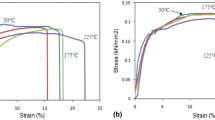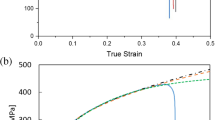Abstract
It is imperative to characterize the crushing behaviour of deep drawn components of tailor welded blanks for their wide applications in different autobody structures. In the present work, extra deep drawing steel sheets were laser welded to produce welded blanks of similar thickness and dissimilar thickness (LWTBs), and these were deformed using a two stage deep drawing setup to fabricate geometrically similar drawn cups consisting of both hemispherical and cylindrical segments. Subsequently, these drawn cups were axially crushed between two flat platens to study collapse modes, load–displacement responses and energy absorption capabilities. The collapse of the drawn cups was found to onset with an inward dimpling of the hemispherical segment. As deformation progressed, the folding of cylindrical section occurred either axisymmetrically or unevenly based on the extent of non-uniform thickness variations across the weld zone (WZ). It was also found that the load–displacement response and energy absorption of the cups were enhanced because of the presence of WZ and thickness difference in LWTBs. Also, finite element-based numerical models were developed to collate the prediction capabilities of three different anisotropic material models viz. Hill48, YLD89, and Stoughton non-associated flow rule (S-NAFR)-based model. All these material models were successfully calibrated to predict the collapse modes, but the S-NAFR model was found to closely predict the load–displacement curves and energy absorption. Furthermore, the assessment of specific energy absorption and crushing force efficiency suggested that lightweight LWTB components can be fabricated with improved crashworthiness performance using sheet materials of different thickness.










Similar content being viewed by others
References
Lokka AM. An economic evaluation of tailor welded blanks in automotive applications. 1997
Song X, Sun G, Li Q. Sensitivity analysis and reliability based design optimization for high-strength steel tailor welded thin-walled structures under crashworthiness. Thin-Walled Struct. 2016;109:132–42. https://doi.org/10.1016/j.tws.2016.09.003.
Baroutaji A, Sajjia M, Olabi AG. On the crashworthiness performance of thin-walled energy absorbers: recent advances and future developments. Thin-Walled Struct. 2017;118:137–63. https://doi.org/10.1016/j.tws.2017.05.018.
Sen D, Pal SK, Panda SK. Fabrication of longitudinal welded tube of aluminum alloy for structural application using friction stir welding process and its characterization. Arch Civ Mech Eng. 2022. https://doi.org/10.1007/s43452-022-00412-w.
Bartczak B, Gierczycka-Zbrozek D, Gronostajski Z, Polak S, Tobota A. The use of thin-walled sections for energy absorbing components: a review. Arch Civ Mech Eng. 2010;10:5–19. https://doi.org/10.1016/S1644-9665(12)60027-2.
Kumar AP, Mohamed MN, Jusuf A, Dirgantara T, Gunawan L. Axial crash performance of press-formed open and end-capped cylindrical tubes—a comparative analysis. Thin-Walled Struct. 2018;124:468–88.
Tasdemirci A, Sahin S, Kara A, Turan K. Crushing and energy absorption characteristics of combined geometry shells at quasi-static and dynamic strain rates: experimental and numerical study. Thin-Walled Struct. 2015;86:83–93. https://doi.org/10.1016/j.tws.2014.09.020.
Katiyar BS, Panda SK, Saha P. Quasi-static crushing behavior of stretch formed domes of laser welded tailored blanks. Thin-Walled Struct. 2021. https://doi.org/10.1016/j.tws.2020.107288.
Kusuda H, Takasago T, Natsumi F. Formability of tailored blanks. J Mater Process Technol. 1997;71:134–40. https://doi.org/10.1016/S0924-0136(97)00159-3.
Xu F, Wang C. Dynamic axial crashing of tailor-welded blanks (TWBs) thin-walled structures with top-hat shaped section. Adv Eng Softw. 2016;96:70–82. https://doi.org/10.1016/j.advengsoft.2016.02.003.
Basak S, Katiyar BS, Orozco-Gonzalez P, Baltazar-Hernandez VH, Arora KS, Panda SK. Microstructure, forming limit diagram, and strain distribution of pre-strained DP-IF steel tailor–welded blank for auto body application. Int J Adv Manuf Technol. 2019. https://doi.org/10.1007/s00170-019-03938-1.
Xu F, Sun G, Li G, Li Q. Experimental study on crashworthiness of tailor-welded blank (TWB) thin-walled high-strength steel (HSS) tubular structures. Thin-Walled Struct. 2014;74:12–27. https://doi.org/10.1016/j.tws.2013.08.021.
Bandyopadhyay K, Panda SK, Saha P, Padmanabham G. Limiting drawing ratio and deep drawing behavior of dual phase steel tailor welded blanks: FE simulation and experimental validation. J Mater Process Technol. 2015;217:48–64. https://doi.org/10.1016/j.jmatprotec.2014.10.022.
Choi Y, Heo Y, Kim HY, Seo D. Investigations of weld-line movements for the deep drawing process of tailor welded blanks. J Mater Process Technol. 2000;108:1–7. https://doi.org/10.1016/S0924-0136(00)00536-7.
Ahmetoglu MA, Brouwers D, Shulkin L, Taupin L, Kinzel GL, Altan T. Deep drawing of round cups from tailor-welded blanks. J Mater Process Tech. 1995;53:684–94. https://doi.org/10.1016/0924-0136(94)01767-U.
Heo YM, Wang SH, Kim HY, Seo DG. The effect of the drawbead dimensions on the weld-line movements in the deep drawing of tailor-welded blanks. J Mater Process Technol. 2001;113:686–91. https://doi.org/10.1016/S0924-0136(01)00672-0.
Abbasi M, Ketabchi M, Labudde T, Prahl U, Bleck W. New attempt to wrinkling behavior analysis of tailor welded blanks during the deep drawing process. Mater Des. 2012;40:407–14. https://doi.org/10.1016/j.matdes.2012.04.015.
Shi Y, Lin Z, Zhu P, Han S. Impact modeling of the weld line of tailor-welded blank. Mater Des. 2008;29:232–8. https://doi.org/10.1016/j.matdes.2006.12.005.
Barlat F, Yoon JW, Cazacu O. On linear transformations of stress tensors for the description of plastic anisotropy. Int J Plast. 2007;23:876–96. https://doi.org/10.1016/j.ijplas.2006.10.001.
Banabic D. Plastic behaviour of sheet metal. In: Sheet metal forming processes. Berlin: Springer; 2010. p. 27–140. https://doi.org/10.1007/978-3-540-88113-1_2.
Saunders FI, Wagoner RH. Forming of tailor-welded blanks. Metall Mater Trans A. 1996;27:2605–16. https://doi.org/10.1007/BF02652354.
Zadpoor AA, Sinke J, Benedictus R. Finite element modeling and failure prediction of friction stir welded blanks. Mater Des. 2009;30:1423–34. https://doi.org/10.1016/j.matdes.2008.08.018.
Padmanabhan R, Baptista AJ, Oliveira MC, Menezes LF. Effect of anisotropy on the deep-drawing of mild steel and dual-phase steel tailor-welded blanks. J Mater Process Technol. 2007;184:288–93. https://doi.org/10.1016/j.jmatprotec.2006.11.051.
Gaied S, Roelandt JM, Pinard F, Schmit F, Balabane M. Experimental and numerical assessment of Tailor–Welded Blanks formability. J Mater Process Technol. 2009;209:387–95. https://doi.org/10.1016/j.jmatprotec.2008.02.031.
Barlat F, Aretz H, Yoon JW, Karabin ME, Brem JC, Dick RE. Linear transfomation-based anisotropic yield functions. Int J Plast. 2005;21:1009–39. https://doi.org/10.1016/j.ijplas.2004.06.004.
Barlat F, Brem JC, Yoon JW, Chung K, Dick RE, Lege DJ, Pourboghrat F, Choi SH, Chu E. Plane stress yield function for aluminum alloy sheets—part 1: theory. Int J Plast. 2003;19:1297–319. https://doi.org/10.1016/S0749-6419(02)00019-0.
Hariharan K, Nguyen NT, Chakraborti N, Lee MG, Barlat F. Multi-objective genetic algorithm to optimize variable drawbead geometry for tailor welded blanks made of dissimilar steels. Steel Res Int. 2014;85:1597–607. https://doi.org/10.1002/srin.201300471.
Kohar CP, Brahme A, Imbert J, Mishra RK, Inal K. Effects of coupling anisotropic yield functions with the optimization process of extruded aluminum front rail geometries in crashworthiness. Int J Solids Struct. 2017;128:174–98. https://doi.org/10.1016/j.ijsolstr.2017.08.026.
Ghorbel O, Koubaa S, Mars J, Wali M, Dammak F. Non associated-anisotropic plasticity model fully coupled with isotropic ductile damage for sheet metal forming applications. Int J Solids Struct. 2019;166:96–111. https://doi.org/10.1016/j.ijsolstr.2019.02.010.
Safaei M, Lee MG, Zang SL, De Waele W. An evolutionary anisotropic model for sheet metals based on non-associated flow rule approach. Comput Mater Sci. 2014;81:15–29. https://doi.org/10.1016/j.commatsci.2013.05.035.
Stoughton TB. A non-associated flow rule for sheet metal forming. Int J Plast. 2002;18:687–714. https://doi.org/10.1016/S0749-6419(01)00053-5.
Basak S, Panda SK, Lee MG. Formability and fracture in deep drawing sheet metals: extended studies for pre-strained anisotropic thin sheets. Int J Mech Sci. 2020. https://doi.org/10.1016/j.ijmecsci.2019.105346.
Banabic D, Aretz H, Comsa DS, Paraianu L. An improved analytical description of orthotropy in metallic sheets. Int J Plast. 2005;21:493–512. https://doi.org/10.1016/j.ijplas.2004.04.003.
Cazacu O, Barlat F. A criterion for description of anisotropy and yield differential effects in pressure-insensitive metals. Int J Plast. 2004;20:2027–45. https://doi.org/10.1016/j.ijplas.2003.11.021.
Yoon JW, Yang DY, Chung K, Barlat F. General elasto-plastic finite element formulation based on incremental deformation theory for planar anisotropy and its application to sheet metal forming. Int J Plast. 1999;15:35–67. https://doi.org/10.1016/S0749-6419(98)00059-X.
Spitzig WA, Richmond O. The effect of pressure on the flow stress of metals. Acta Metall. 1984;32:457–63. https://doi.org/10.1016/0001-6160(84)90119-6.
Lee JH. Research note on a simple model for pressure-sensitive strain-hardening materials. Int J Plast. 1988;4:265–78. https://doi.org/10.1016/0749-6419(88)90014-9.
Stoughton TB, Yoon JW. A pressure-sensitive yield criterion under a non-associated flow rule for sheet metal forming. Int J Plast. 2004;20:705–31. https://doi.org/10.1016/S0749-6419(03)00079-2.
Hill R. A theory of the yielding and plastic flow of anisotropic metals. Proc R Soc Lond Ser A Math Phys Sci. 1948;193:281–97. https://doi.org/10.1098/rspa.1948.0045.
ASTM E-517, Standard test method for plastic strain ratio R for sheet metal. In: ASTM international, pp 1–8, 2010. https://doi.org/10.1520/E0517-00R10.
Hariharan K, Nguyen NT, Chakraborti N, Barlat F, Lee MG. Determination of anisotropic yield coefficients by a data-driven multiobjective evolutionary and genetic algorithm. Mater Manuf Process. 2015;30:403–13. https://doi.org/10.1080/10426914.2014.941480.
Nguyen NT, Hariharan K, Chakraborti N, Barlat F, Lee MG. Springback reduction in tailor welded blank with high strength differential by using multi-objective evolutionary and genetic algorithms. Steel Res Int. 2015;86:1391–402. https://doi.org/10.1002/srin.201400263.
Barlat F, Lian K. Plastic behavior and stretchability of sheet metals. Part I: a yield function for orthotropic sheets under plane stress conditions. Int J Plast. 1989;5:51–66. https://doi.org/10.1016/0749-6419(89)90019-3.
Rojek J, Hyrcza-Michalska M, Bokota A, Piekarska W. Determination of mechanical properties of the weld zone in tailor-welded blanks. Arch Civ Mech Eng. 2012;12:156–62. https://doi.org/10.1016/j.acme.2012.04.004.
Mamalis AG, Johnson W. The quasi-static crumpling of thin-walled circular cylinders and frusta under axial compression. Int J Mech Sci. 1983;25:713–32. https://doi.org/10.1016/0020-7403(83)90078-4.
Ghasemabadian MA, Kadkhodayan M, Altenhof W, Bondy M, Magliaro J. An experimental study on the energy absorption characteristics of single- and bi-layer cups under quasi-static loading. Int J Crashworthiness. 2018. https://doi.org/10.1080/13588265.2018.1433348.
Acknowledgements
The authors are greatly thankful to Prof. Shamik Basak of Department of Mechanical and Industrial Engineering, Indian Institute of Technology Roorkee, India for his help in FE simulations of this study.
Funding
No funding was received for conducting this study.
Author information
Authors and Affiliations
Contributions
Conceptualization: Bhupesh Singh Katiyar, Sushanta Kumar Panda, Partha Saha; methodology: Bhupesh Singh Katiyar, Sushanta Kumar Panda, Partha Saha; formal analysis and investigation: Bhupesh Singh Katiyar, Sushanta Kumar Panda; writing—original draft preparation: Bhupesh Singh Katiyar; writing—review and editing: Bhupesh Singh Katiyar, Sushanta Kumar Panda, Partha Saha; Resources: Sushanta Kumar Panda, Partha Saha; supervision: Sushanta Kumar Panda, Partha Saha.
Corresponding author
Ethics declarations
Conflict of interest
The authors declare that they have no conflict of interest.
Ethical approval
This article does not contain any studies with human participants or animals performed by any of the authors.
Additional information
Publisher's Note
Springer Nature remains neutral with regard to jurisdictional claims in published maps and institutional affiliations.
Rights and permissions
Springer Nature or its licensor holds exclusive rights to this article under a publishing agreement with the author(s) or other rightsholder(s); author self-archiving of the accepted manuscript version of this article is solely governed by the terms of such publishing agreement and applicable law.
About this article
Cite this article
Katiyar, B.S., Panda, S.K. & Saha, P. Experimental and numerical analyses on crushing behaviour of drawn cups of laser welded tailored blanks under axial loading. Archiv.Civ.Mech.Eng 22, 211 (2022). https://doi.org/10.1007/s43452-022-00537-y
Received:
Revised:
Accepted:
Published:
DOI: https://doi.org/10.1007/s43452-022-00537-y




